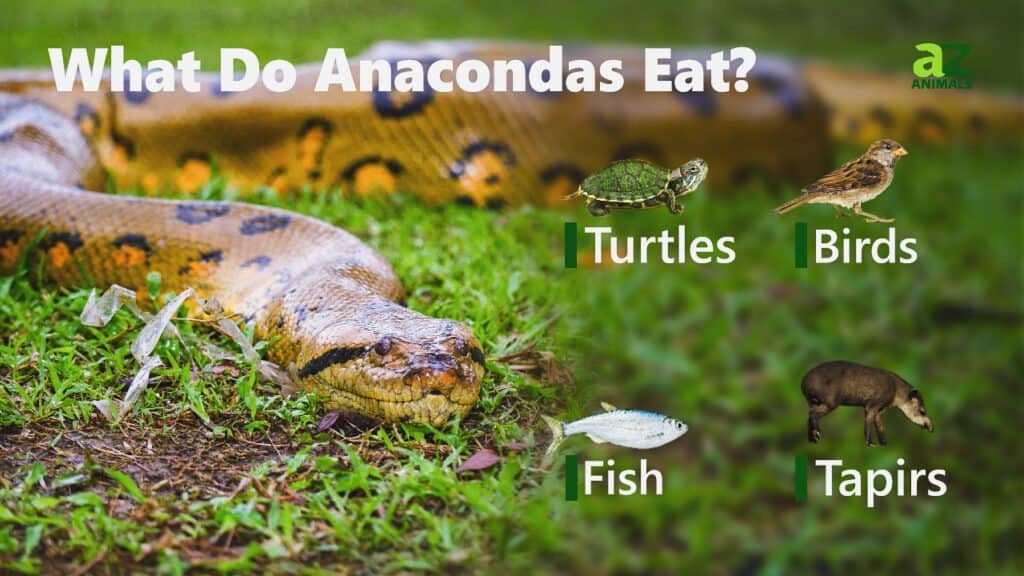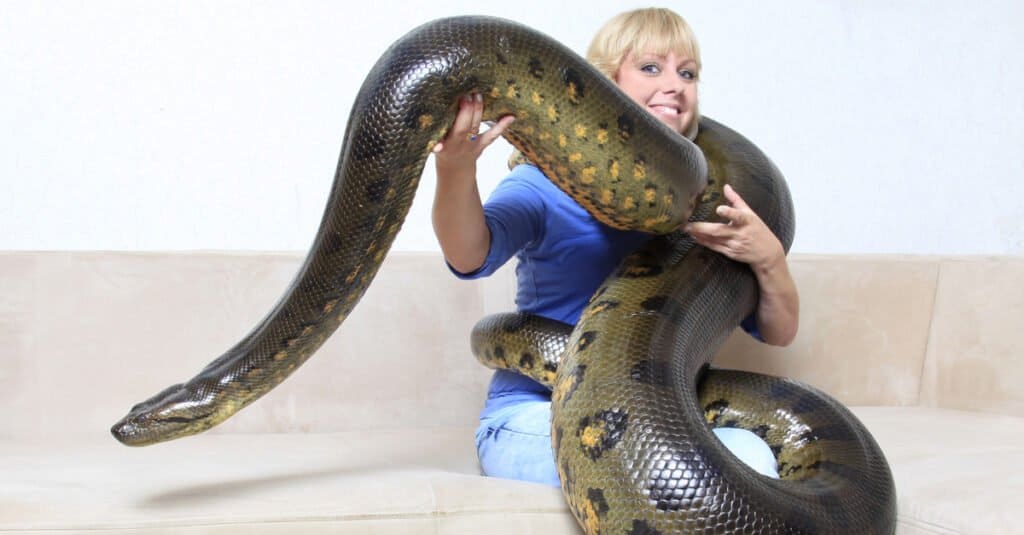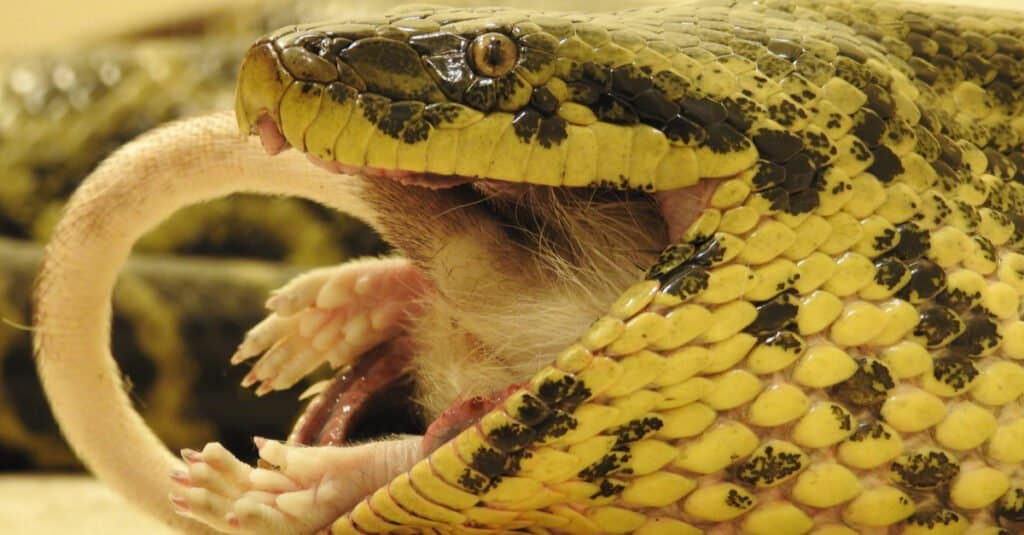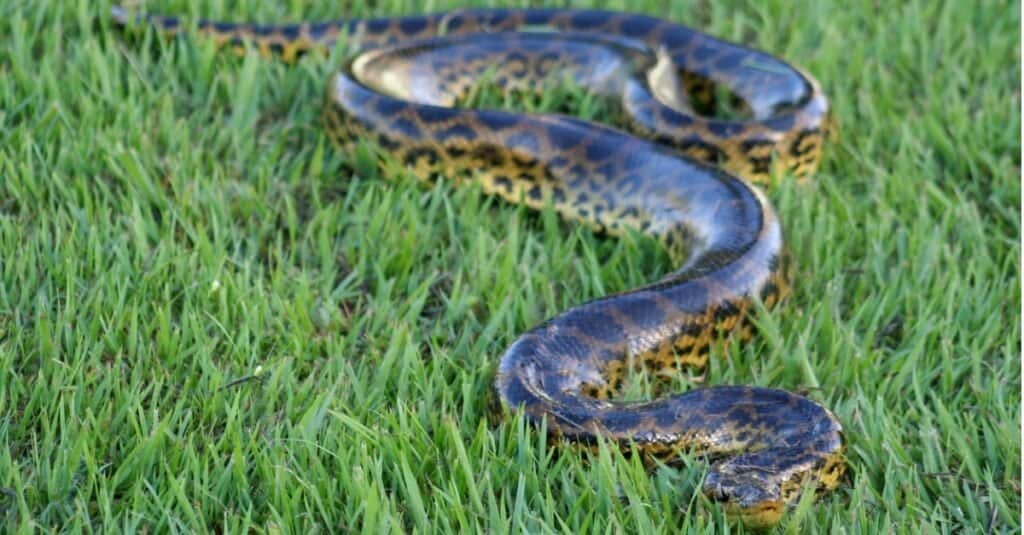Perhaps it is understandable why a lot of people fear snakes. They can kill anything using their venoms and powerful squeeze, not to mention they have a terrifying appearance. Anacondas are no exception. As a snake that can grow up to 30 feet long, it comes as no surprise that anacondas have been the subjects of many frightening films and monster stories. The green anaconda is the heaviest snake species, weighing up to 550 pounds. With their enormous size and weight, anacondas are undoubtedly strong too and can squeeze any animal wrapped within its body to death. For snakes with long, slender bodies, we can’t help but wonder, what do anacondas eat? And how do they eat and digest their food?
Snakes are one of nature’s deadliest predators, but the credit mostly goes to their venomous bite. However, the case is different for anacondas. They are not venomous, so how do they kill their prey? Among all animals on the planet, anacondas possess the strongest squeeze power, which equates to the strength of ten men. They even have enough strength to kill carnivorous hunters like jaguars or larger prey like deer.
What Do Anacondas Eat?

Anacondas are exclusive carnivores who eat a diet that consists of birds, deer, caimans, jaguars, turtles, and others. As aquatic snakes with a voracious appetite, anacondas can eat any animal they can manage to wrap their long, slender bodies around. Yet, they prefer specific food to include in their all-meat diet. Here is a list of animals anacondas love to include in their carnivorous diet:
Since anacondas inhabit marshes and swamps, they prey on water-dwelling animals too. Anacondas slide clumsily and slowly on land, but they are fast and adept hunters in water. Anacondas can hide under the water surface to ambush their prey. Animals that anacondas usually eat in water include:
Apart from their impressive hunting skills paired with their incredible squeeze power, anacondas also use camouflage through their scales’ dark green hue and unique patterns to help them hide themselves during an attack.
What Do Anacondas Eat as Pets?

As pets, anacondas eat chickens, small pigs, rodents, and fish.
©Holger Kirk/Shutterstock.com
Anacondas must still get the same amount of nourishment they typically get in the wild, even in captivity. Anacondas can be a little picky, so feeding them their favorite prey is better. Pet anacondas can eat a diet that includes:
Although most people may think that pet anacondas should be fed with live prey, it is unnecessary. Snake specialists even recommend feeding anacondas with frozen/thawed food as live prey like rodents can fight the anaconda using their sharp teeth and claws and may cause some injuries.
How Do Anacondas Eat?

Anacondas kill their prey by suffocating them and swallowing them whole.
©Ariawesomeness/Shutterstock.com
Like nonvenomous boas, anacondas are constrictors, which means they kill their prey by wrapping and coiling their long bodies around their prey and suffocating them by squeezing tighter and tighter until their victims lose their breath. Then, once their victim is dead, anacondas will start to swallow their prey whole, from the head to its tail. They do this so the prey will be smoother to swallow as the legs fold up together. Anacondas have sharp, recurved teeth that help them easily eat their victim. They also have an impressive girth that extends up to 3 feet long, helping them eat huge prey.
Anacondas do not crush the bones of their prey as much as possible because they swallow the body of their victim whole, and crushed bones can puncture through their digestive tract. Anacondas may seem like their jaws do not open, but these mandibles can unhinge for as much as four times the anaconda’s body width. Inside their jaws, anacondas have movable joints that are loosely connected to their skull, letting them open their jaws wide enough to eat large prey. The anaconda’s powerful muscles create wave contractions that help them push their victims further down their throats and bodies. An anaconda can go long without eating, especially after devouring huge prey.
How Do Anacondas Hunt for Food?

The forked tongue and Jacobson’s organ of anacondas help them detect animal smells.
©iStock.com/Schumaher
Anacondas are native to South American rainforests and are non-venomous. Since they do not have poison that can easily kill their prey, unlike other types of snakes, anacondas rely on their strength when it comes to hunting. Anacondas are natural hunters in the wild, and despite slithering across the ground, they can easily take on bigger animals like deer.
Anacondas are impressive hunters who can kill their victims on land or the water surface. Anacondas can feel vibrations on the ground when prey is nearby. They are also equipped with eyes and nostrils at the top of their head, which helps them see and breathe even though their bodies are submerged beneath the water surface while stalking their prey.
The forked tongue and Jacobson’s organ of anacondas are also very useful in detecting specific animal smells and chemicals, which is why they often hiss and stick out their tongues. An anaconda also uses the pit organs on the top of its upper lip to sense heat signatures from possible prey. Even though anacondas don’t have sharp eyesight or a sense of smell, they are still good at hunting, thanks to their other senses.
Despite anacondas being great hunters, their fierceness to prey on larger carnivores like jaguars and caimans can sometimes injure them and even cause their death.
Do Anacondas Chew and Digest Their Food?
Anacondas do not chew their food. They do not have molars to do so, and the only dentition they have are sharp fangs to ease their feeding. However, once the whole body of their prey is swallowed completely, they digest them slowly using powerful acid, enzymes, and gastric juices that can break down their victim’s body. The small intestines of anacondas continue to digest the animal as they pass down the anaconda’s digestive tract. The small intestines then soak up the nutrients.
The photo featured at the top of this post is © Patrick K. Campbell/Shutterstock.com
Discover the "Monster" Snake 5X Bigger than an Anaconda
Every day A-Z Animals sends out some of the most incredible facts in the world from our free newsletter. Want to discover the 10 most beautiful snakes in the world, a "snake island" where you're never more than 3 feet from danger, or a "monster" snake 5X larger than an anaconda? Then sign up right now and you'll start receiving our daily newsletter absolutely free.
Thank you for reading! Have some feedback for us? Contact the AZ Animals editorial team.






